
The Noctuidae, commonly known as owlet moths, cutworms or armyworms, are the most controversial family in the superfamily Noctuoidea because many of the clades are constantly changing, along with the other families of the Noctuoidea. It was considered the largest family in Lepidoptera for a long time, but after regrouping Lymantriinae, Catocalinae and Calpinae within the family Erebidae, the latter holds this title now. Currently, Noctuidae is the second largest family in Noctuoidea, with about 1,089 genera and 11,772 species. However, this classification is still contingent, as more changes continue to appear between Noctuidae and Erebidae.

The beet armyworm or small mottled willow moth is one of the best-known agricultural pest insects. It is also known as the asparagus fern caterpillar. It is native to Asia, but has been introduced worldwide and is now found almost anywhere its many host crops are grown. The voracious larvae are the main culprits. In the British Isles, where it is an introduced species and not known to breed, the adult moth is known as the small mottled willow moth.

The African armyworm, also called okalombo, kommandowurm, or nutgrass armyworm, is a species of moth of the family Noctuidae. The larvae often exhibit marching behavior when traveling to feeding sites, leading to the common name "armyworm". The caterpillars exhibit density-dependent polyphenism where larvae raised in isolation are green, while those raised in groups are black. These phases are termed solitaria and gregaria, respectively. Gregaria caterpillars are considered very deleterious pests, capable of destroying entire crops in a matter of weeks. The larvae feed on all types of grasses, early stages of cereal crops, sugarcane, and occasionally on coconut. The solitaria caterpillars are less active and undergo much slower development. The species is commonly found in Africa, but can also be seen in Yemen, some Pacific islands, and parts of Australia. African armyworm outbreaks tend to be devastating for farmland and pasture in these areas, with the highest-density outbreaks occurring during the rainy season after periods of prolonged drought. During the long dry seasons ("off-season"), the population densities are very low and no outbreaks are seen.
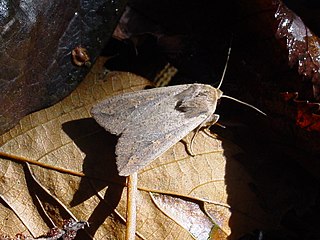
Mythimna unipuncta, the true armyworm moth, white-speck moth, common armyworm or rice armyworm, is a nocturnal agricultural pest belonging to the family Noctuidae. This moth is also commonly referred to by the scientific name Pseudaletia unipuncta. The species was first described by Adrian Hardy Haworth in 1809. Mythimna unipuncta is found in the Americas and in parts of Europe, Africa and Asia. Its original distribution is North and South America. It has been introduced to other places from there. They are known as armyworms because the caterpillars move in lines as a massive group, like an army, from field to field, damaging crops.

Mythimna separata, the northern armyworm, oriental armyworm or rice ear-cutting caterpillar, is a moth of the family Noctuidae. It is found in China, Japan, South-east Asia, India, eastern Australia, New Zealand, and some Pacific islands. It is one of the major pests of maize in Asia. The species was first described by Francis Walker in 1865.
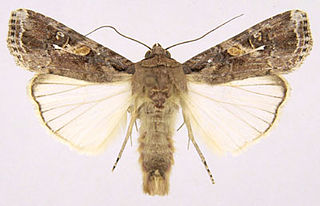
The fall armyworm is a species in the order Lepidoptera and is the larval life stage of a fall armyworm moth. The term "armyworm" can refer to several species, often describing the large-scale invasive behavior of the species' larval stage. It is regarded as a pest and can damage and destroy a wide variety of crops, which causes large economic damage. Its scientific name derives from frugiperda, which is Latin for lost fruit, named because of the species' ability to destroy crops. Because of its propensity for destruction, the fall armyworm's habits and possibilities for crop protection have been studied in depth. It is also a notable case for studying sympatric speciation, as it appears to be diverging into two species currently. Another remarkable trait of the larva is that they practice cannibalism as a disease control mechanism.

Spodoptera is a genus of moths of the family Noctuidae erected by Achille Guenée in 1852. Many are known as pest insects. The larvae are sometimes called armyworms. The roughly thirty species are distributed across six continents.
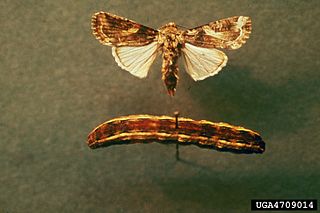
Spodoptera ornithogalli is a moth of the family Noctuidae.
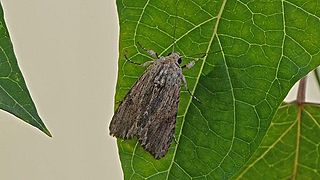
Spodoptera eridania is a moth that is known to be a pest. They are one of the most important defoliators in the tropical and subtropical regions of the western hemisphere that feed heavily on plants while they are young, often resulting in skeleton leaves on their food plants. They are also heavy feeders on tomato in Florida. There is a lot of development in producing pesticides against the S. eridania, specifically a neem-based pesticide that can result in smaller and prolonged development. The wingspan is 33–38 mm. Adults are on wing year-round. The larvae feed on various weeds but prefer Amaranthus species and Phytolacca americana.
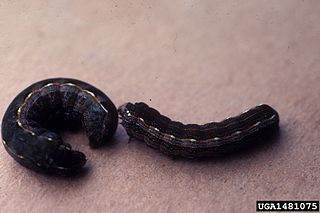
Spodoptera latifascia, commonly known as the lateral-lined armyworm, garden armyworm, or velvet armyworm, is a moth of the family Noctuidae found from Central America and the Antilles into North America. S. cosmioides, which can be found in South America, was formerly considered a separate species, but has been placed in synonymity with S. latifascia
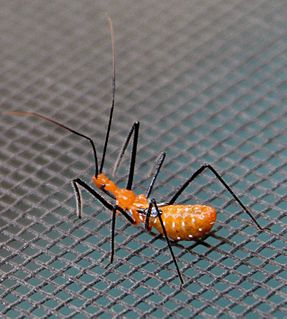
Zelus longipes is an assassin bug (Reduviidae) that is a member of the harpactorinae subfamily. Its distribution ranges include southern North America, Central America, and South America, especially in agroecosystems in Brazil.

Spodoptera mauritia, the lawn armyworm or paddy swarming caterpillar, is a moth of the family Noctuidae. The species was first described by Jean Baptiste Boisduval in 1833. Able to eat many types of food, it is a major pest throughout the world.

Simplicia cornicalis is a litter moth of the family Erebidae. The species was first described by Johan Christian Fabricius in 1794. It is found in south-eastern Asia and the Pacific. Records include New Caledonia, Réunion, Thailand, Fiji, Hawaii, India, Sri Lanka, the Society Islands, as well as New South Wales and Queensland in Australia. It is an introduced species in southern Florida and Louisiana in the United States.
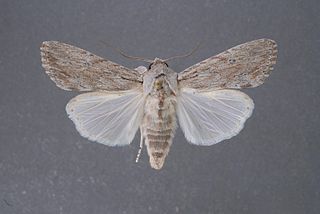
Spodoptera albula is a moth of the family Noctuidae found from the southern United States, south to South America.

Spodoptera pulchella, the Caribbean armyworm moth, is a moth of the family Noctuidae found in Florida and Texas, Central America, the Greater Antilles, and the Bahamas. It was first described by Gottlieb August Wilhelm Herrich-Schäffer in 1868.
Scopula umbilicata, the swag-lined wave moth, is a moth of the family Geometridae. The species was first described by Johan Christian Fabricius in 1794. It is found from the southern part of the United States to South America and the West Indies.
Lygropia tripunctata, the sweetpotato leafroller, is a moth in the family Crambidae. It was described by Johan Christian Fabricius in 1794. It is found in the United States, where it has been recorded from Texas to South Carolina and Florida. It is also found from the West Indies and Central America to Brazil.
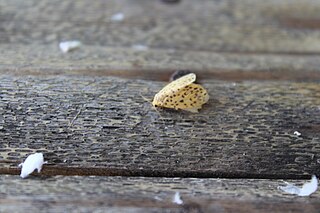
Polygrammodes eleuata, the red-spotted sweetpotato moth or many-spotted moth, is a moth in the family Crambidae. It was described by Johan Christian Fabricius in 1777. It is found in Central and South America, on the Antilles and in the southern United States, where it has been recorded from Florida.

Spodoptera androgea, the androgea armyworm moth, is a species of cutworm or dart moth in the family Noctuidae. It is found in North America.

















